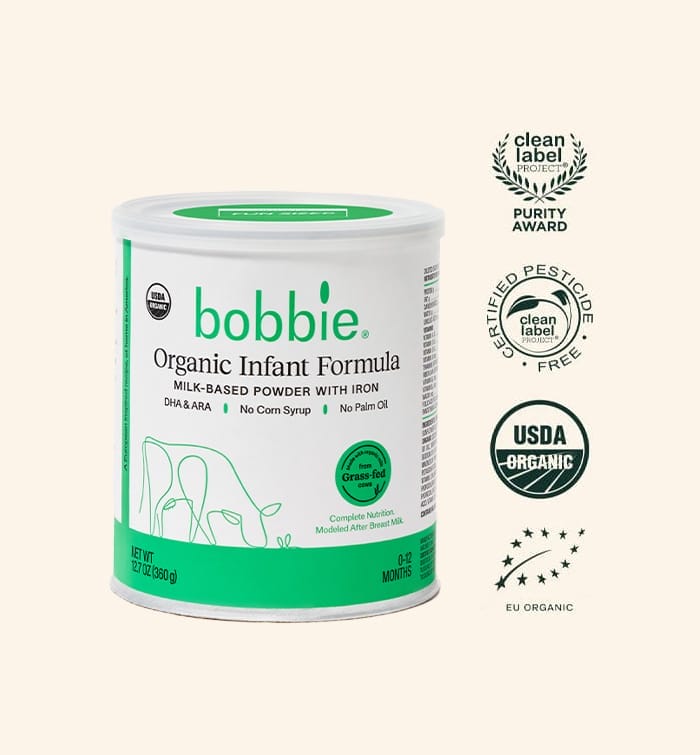We are proud to say that these posts are not sponsored. Our editorial team of Bobbie moms and writers personally select each featured product. If you buy something through our links, we may earn an affiliate commission, at no cost to you.
Have you ever wondered just how long infant formula has been around? We often forget there was a time before infant formula, and it’s hard to imagine life without it. Read on to find out more about the history and science of infant formula.
What did parents who couldn’t breastfeed do before there was formula?
This is a question that we don’t think about very much in the US these days with regulated infant formula being so easily available. But what happened if your breast milk supply was too low to provide enough nutrition for your baby in the days before infant formula was invented? We’re glad you asked!
What is a wet nurse?
Before 1900, women who weren’t able to breastfeed, and could afford the expense, hired a wet nurse to breastfeed their infant. Simply put, a wet nurse is someone who breastfeeds another woman’s child. There is evidence of this practice taking place as far back as 2000 BC!1
Interestingly, there were some points in history where having a wet nurse was seen as a status symbol and wealthy families may have hired a wet nurse even without having a medical need for one.1
What is dry nursing?
So what did you do if you couldn’t afford a wet nurse but still needed a way to feed your baby besides breastfeeding? Dry nursing!2
Dry nursing refers to feeding infants animal milk from cows, donkeys, goats and other animals. Fun fact- donkey’s milk was thought to be especially healthy because it looked the most like human breast milk.2 And, believe it or not, orphanages kept lactating goats and donkeys on site and fed infants directly from them.3
The invention of bottles, pasteurization and refrigeration
A source of milk wasn’t the only challenge before modern formula. So was a way to feed it and a way to keep it fresh.
Like wet nursing, evidence of different types of cups, bottles and other infant feeding devices (like a perforated cow’s horn!) dates back to ancient times. Beyond animal milk, infants were also fed items like bread soaked in water or milk or cereal soaked in broth through these devices, especially when they didn’t seem to be gaining enough weight.1
Instead of using these items, some babies drank milk directly from the animal. But before you cringe at this idea, remember that these were the times before running hot water, dishwashers and much knowledge about germs, so feeding devices were likely to be crawling with bacteria. As a matter of fact, during this time 1 of every 3 babies who weren’t breastfed died before their 1st birthday.4
A few more inventions came along in the late 1800s and early 1900s that helped advance infant formula practices. First, the rubber nipple was invented in 1845, which was easier to clean than prior feeding devices. Luckily, it was also around this time that we learned about germs and the need to clean everything for babies well. Pasteurization, which uses heat to kill bacteria, was also invented in this era and iceboxes (or early refrigerators) became common in households.1,2
All of these items, inventions and concepts were needed to support the invention of infant formula as a feeding alternative.
When was infant formula invented?
The first known commercial infant formula was a cow’s milk-based formula made in Germany in 1865. It was invented by a chemist named Justus von Liebig, who had a passion for improving nutrition for others after growing up in a community where food was in short supply. He called his powdered formula Liebig’s Soluble Food for Babies and it was made of cow’s milk, wheat flour, malt flour and potassium bicarbonate.4
From then until the mid-1950s, some parents used commercial products like this, but most made their own formula at home with ingredients like Karo syrup and canned milk. Parents would also feed babies things like orange juice and cod-liver oil to prevent diseases that could occur from the lack of vitamins in homemade formulas.3
In the late 1800s, another important invention was created that led further down the path to today’s formula- evaporated milk. The process of evaporating water out of milk and sterilizing it left a product that resulted in good growth when fed to infants instead of breast milk. The evaporated milk was usually mixed with sugar or corn syrup before being given, and babies were typically also given vitamin supplements. This was the main breast milk alternative used until the 1950s.2
However, leading up to the 1950s, scientists were hard at work on a mission to create a formula that more closely mimicked breast milk. During this time, soy-based formulas and other alternative formulas were also coming to market for infants who were not able to tolerate cow’s milk-based formula.2

Shop Bobbie Organic Infant Formula
Bobbie Organic Infant Formula is a USDA Organic, EU-style infant formula that meets all FDA requirements. It is a complete nutrition milk-based powder modeled after breast milk and is easy on tummies. It is non-GMO and doesn't have corn syrup, palm oil, or maltodextrin. Learn more about Bobbie.
The importance of the Infant Formula Act
In the late 1960s, the American Academy of Pediatrics first released recommendations for the amount of vitamins and minerals that should be in formula, and in 1980 Congress passed the Infant Formula Act, which set quality controls, mandated testing, and regulated minimum and maximum amounts of nutrients in formula.2
These days, infant formula is regulated by the Food and Drug Administration (FDA), which enforces quality and nutritional standards.5
Present day infant formula options
Since the invention of infant formula and early alternatives for babies who couldn’t tolerate cow’s milk-based formula in the 1950s, scientists have continued to closely study breast milk and infant formula and work to create formula that’s as close to breast milk as possible. Just as (if not more) importantly, there has been a lot of attention on the special nutritional needs of certain infants, like those who are born prematurely.
While it’s so interesting to look back at all the history and science that got us to where we are today, we are certainly grateful to be living in a time with so many nutritious and healthy feeding alternatives when we need them!

Shop Bobbie Organic Infant Formula
Bobbie Organic Infant Formula is a USDA Organic, EU-style infant formula that meets all FDA requirements. It is a complete nutrition milk-based powder modeled after breast milk and is easy on tummies. It is non-GMO and doesn't have corn syrup, palm oil, or maltodextrin. Learn more about Bobbie.
Sources:
1- A history of infant feeding | The Journal of Perinatal Education
2- A concise history of infant formula (twists and turns included) | Contemporary Pediatrics
3- In pursuit of better baby formula | Smithsonian Magazine
4- How formula milk shaped the modern workplace | BBC
5- Questions & answers for consumers concerning infant formula | Food and Drug Administration

